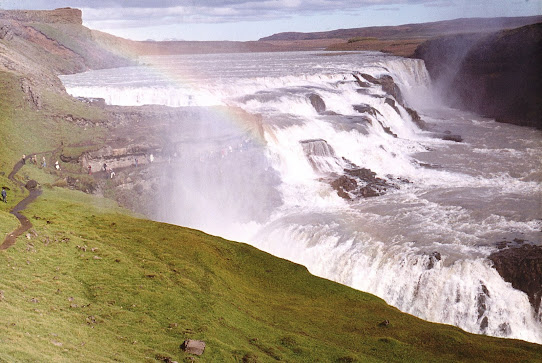back to: introduction and index - previous day - next day
Thursday 25th August 1977
Neville and I arrived in Iceland yesterday for a walking tour which does not begin properly until tomorrow. We have therefore hired a car for a trip to Thingvellir, Geysir and Gullfoss.
Two others from the party have joined us: Gavin from Aberdeen who is a factory inspector, and Steve, a nuclear chemist from London. Steve is the one we spotted with his rucksack at the airport, who looks remarkably like our friend Gavin. But this other chap is also called Gavin. This is very confusing. I keep calling Steve, Gavin, and Gavin, Steve.
At Thingvellir, you see a cliff face. As you begin to ascend you suddenly come to a gorge running parallel with the face. A river runs along the bottom of the gorge from a waterfall on the upper cliff. It runs for some way before breaking through the lower cliff into the lowland. The strange topography marks the boundary between the North American and Eurasion tectonic plates. It was also the site of the Althing, the ancient Icelandic parliament, which met there for nearly nine hundred years until 1798.
Even in the sun it is cold, and there are intermittent showers.
Geysir, of course, has the geothermal hot water geysers. Out of holes in the ground that resemble the craquelure an avant-garde oil painting, they eject pillars of hot water and steam high into the air with a terrifying roar, subsiding into witches’ cauldrons of angry boiling water which gurgle ominously. It demands nerves of steel to stand close as they threaten to erupt and dissolve you.
Photographing them requires split-second reflexes which Steve, apparently, does not have. He uses half a film and still misses it. If the famous but almost inactive, eighty-foot Great Geysir erupted, he would probably click the shutter just too late have to wait with his camera for the next thirty-five years until it went off again. He would then, almost certainly, still miss it.
The sulphurous fumes, the noise, the hell on earth – I decided there and then it was best to be good and go to heaven. Film does not really do it justice.
The same is true of Gullfoss. All that rushing water takes me back to the canning factory where I have been working, cleaning the machinery with a hose pipe. Channel that lot through and it would be spotlessly clean in an instant, assuming there was any machinery left, or indeed any building. I wonder what it would be like to jump in.
We end the trip with a short ride north towards
the Langjökull ice cap, the second largest in Iceland and source of the Gullfoss waters, but we turn back at
the first river crossing. We are in a Volkswagen, not a Land Rover.
Formal,
polite conversation most of the day. It will be more spontaneous when
everyone gets to know each other. Tomorrow is the first day of the
walking tour, proper.
(next part)
Some names and personal details have been changed. I would be delighted to hear from anyone who was there.










